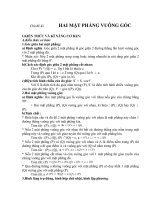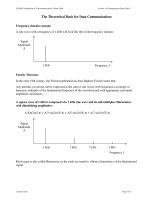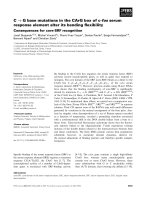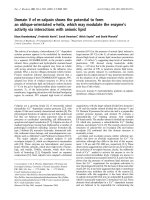AAE556 v g flutter lecture 32 The Vg method
Bạn đang xem bản rút gọn của tài liệu. Xem và tải ngay bản đầy đủ của tài liệu tại đây (341.78 KB, 19 trang )
AAE 556
Aeroelasticity
The V-g method
g
k decreasing
V/bωθ
mode 1
mode 2
flutter
point
Airfoil dynamic motion
Ma
e
P=-L
θ(t)
V
xθ
aero K θ
center T
Kh h
This is what we’ll get when we use the V-g
method to calculate frequency vs. airspeed and
include Theodorsen aero terms
1.6
1.4
Frequency Ratio (ω / ω )
θ
1.2
1
0.8
0.6
0.4
0.2
0
0
0.5
1
1.5
2
2.5
3
Velocity (V/ ω b)
θ
3.5
4
4.5
5
When we do the V-g method here is
damping vs. airspeed
1
0.8
0.6
0.4
flutter
0.2
g
0
divergence
-0.2
-0.4
-0.6
-0.8
-1
0
0.5
1
1.5
2
2.5
3
Velocity (V/ ω b)
θ
3.5
4
4.5
5
To create harmonic motion at all airspeeds we
need an energy source or sink at all airspeeds
except at flutter
i
i
Input energy when the aero damping
takes energy out (pre-flutter)
Take away energy when the aero forces
put energy in (post-flutter)
2D airfoil free vibration with everything
but the kitchen sink
&
h
&&
&&
Mh + Mxθ θ + K h ( g h + g ) + h = P = − Leiωt
ω
( −ω M + K
2
h
)
1 + i ( g h + g ) h − ω Mxθ θ = P
2
&
θ
&&
&&
Iθ θ + Mxθ h + Kθ ( gθ + g ) + θ = M a = M a eiωt
ω
( −ω I
2
θ
)
+ Kθ 1 + i ( gθ + g ) θ − ω Mxθ h = M a
2
We will get matrix equations that
look like this
A B h / b 0
=
D E θ 0
m
µ=
2
πρ b
…but have structural damping that
requires that …
A(k, ω , g)E(k, ω , g) − B(k)D(k) = 0
The EOM’s are slightly different from those
before (we also multiplied the previous
equations by µ)
B h / b 0 Each term contains inertial,
structural stiffness, structural
=
E θ 0 damping and aero
information
A
D
A = µ{1− (ω / ω )[1 + i(gh + g)]} + Lh
2
h
2
B = µ x θ + Lα =- Lh (1 / 2 + a)
2
θ
1
D =µxθ +M h −Lh +a ÷
2
E = µ r {1 − ( ω / ω )[1 + i(gθ + g)]}
2
θ
2
− Mh (1 / 2 + a) + Mα − Lα (1 / 2 + a) + Lh (1 / 2 + a) 2
Look at the “A” coefficient and identify the
eigenvalue – artificial damping is added to keep
the system oscillating harmonically
ωh 2
A = µ 1 −
÷ 1 + i ( g h + g fake ) + Lh
ω
(
)
We change the eigenvalue from a pure frequency term to a
frequency plus fake damping term. So what?
ωh 2 ωθ 2
A = µ 1 −
1 + ig fakier ) + Lh
(
÷
÷
ωθ ω
Ω = (ω / ω )(1 + ig) = Ω + iΩ
2
2
θ
2
2
R
2
I
The three other terms are also
modified
A B h / b 0
D E θ = 0
Each term contains inertial,
structural stiffness, structural
damping and aero
information
B = µ x θ + Lα =- Lh (1 / 2 + a)
D =+ µ x θ + Mh − L h (1/ 2 + a)
2
ω
2
θ
E = µ rθ 1 −
÷ ( 1 + ig )
ω
2
1
1
1
− M h + a ÷+ M α − Lα + a ÷+ Lh + a ÷
2
2
2
To solve the problem we input k and
compute the two values of Ω2
2
2
ωθ
ωθ
Ω = ÷ + ig ÷ = Ω 2R + iΩ 2I
ω
ω
2
Ω = (Ω ) + i(Ω )
2
1
2
R 1
2
I 1
Ω = (Ω ) + i(Ω )
2
2
2
R 2
2
I 2
The value of g represents the amount of
damping that would be required to keep
the system oscillating harmonically. It
should be negative for a stable system
ω 1 = ω θ / (Ω R )1
g1 = (Ω ) / (Ω )
2
I 1
2
R 1
ω 2 = ω θ / (Ω R ) 2
g2 = (Ω 2I )2 / (Ω 2R )2
Now compute airspeeds
using the definition of k
V1 = bω 1 / k
ω 1 = ω θ / (Ω R )1
Remember that we always input k so the same
value of k is used in both cases. One k, two
airspeeds and damping values
V 2 = bω 2 / k
ω 2 = ω θ / (Ω R ) 2
Typical V-g Flutter Stability Curve
g ' = g h + g = gθ + g
gh ≈ gθ
k decreasing
g
V/bωθ
mode 1
flutter
point
mode 2
Ω = (ω / ω )(1 + ig′ )
2
2
θ
2
Now compute the eigenvectors
V1 = bω 1 / k
h
2
2
(bθ / h)1 = −D / E(Ω1 ) ;
= 1 (Ω = Ω 1 )
b
V 2 = bω 2 / k
(h / b θ )2 = − B / A(Ω 2 ) ; θ = 1
(Ω 2 = Ω 22 )
Example
Two-dimensional airfoil
mass ratio, µ = 20
quasi-static flutter speed VF = 160 ft/sec
gθ = g h = 0.03
b = 3.0 ft
Example
k = 0.32
1 / k = 3.1250
ω h = 10 rad / sec
ωθ = 25 rad / sec.
Lα = −13.4078− i3.7732
Lh = −0.10371− i40973
Mα = 0.37500 − i3.1250
Mh = 0.50000
The determinant
k = 0.32
A = 19.896 − i4.0973 − 3.2Ω
2
B = −11.3767 − i2.5440
D = 2.5311+ i1.22919
2
E = 9.2380 − i2.3618 − 5.0Ω
A E − BD = 16(Ω) 4 + (−129.043+ i28.044)Ω2 + 199.794 − i64. 418= 0
Final results for this k value – two
g’s and V’s
b = 3.0 ft
Ω = 4.0326 − i0.87638± 3.0067 − i3.0420
2
Ω − 4.0326 − i0.87638± (1.9084− i0.79702)
2
Ω12 = 5.9410 − i1.67340
ω 1 = 10.257 rad / sec (ω h = 10 rad / sec)
Ω 22 = 2.1242− i0.07936
V1 = 96.157 ft / sec
g1 = g + gθ = −0.2817
ω 2 = 17.153 rad / sec (ω θ = 25 rad / sec) V 2 = 160.810 ft / sec
g 2 = g + gθ = −0.0374
Final results
Flutter
g = 0.03









